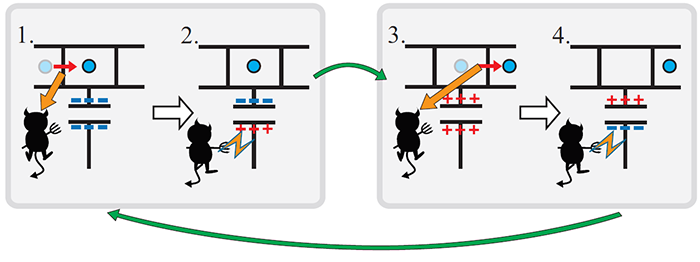The European Union’s Graphene Flagship project has provided a series of highlights in place of an overview for the project’s ramp-up phase (in 2013 the Graphene Flagship was announced as one of two winners of a science competition, the other winner was the Human Brain Project, with two prizes of 1B Euros for each project). Here are the highlights from the April 19, 2016 Graphene Flagship press release,
Graphene and Neurons – the Best of Friends
Flagship researchers have shown that it is possible to interface untreated graphene with neuron cells whilst maintaining the integrity of these vital cells [1]. This result is a significant first step towards using graphene to produce better deep brain implants which can both harness and control the brain.
Graphene and Neurons
This paper emerged from the Graphene Flagship Work Package Health and Environment. Prof. Prato, the WP leader from the University of Trieste in Italy, commented that “We are currently involved in frontline research in graphene technology towards biomedical applications, exploring the interactions between graphene nano- and micro-sheets with the sophisticated signalling machinery of nerve cells. Our work is a first step in that direction.”
[1] Fabbro A., et al., Graphene-Based Interfaces do not Alter Target Nerve Cells. ACS Nano, 10 (1), 615 (2016).
Pressure Sensing with Graphene: Quite a Squeeze
The Graphene Flagship developed a small, robust, highly efficient squeeze film pressure sensor [2]. Pressure sensors are present in most mobile handsets and by replacing current sensor membranes with a graphene membrane they allow the sensor to decrease in size and significantly increase its responsiveness and lifetime.
Discussing this work which emerged from the Graphene Flagship Work Package Sensors is the paper’s lead author, Robin Dolleman from the Technical University of Delft in The Netherlands “After spending a year modelling various systems the idea of the squeeze-film pressure sensor was formed. Funding from the Graphene Flagship provided the opportunity to perform the experiments and we obtained very good results. We built a squeeze-film pressure sensor from 31 layers of graphene, which showed a 45 times higher response than silicon based devices, while reducing the area of the device by a factor of 25. Currently, our work is focused on obtaining similar results on monolayer graphene.”
[2] Dolleman R. J. et al., Graphene Squeeze-Film Pressure Sensors. Nano Lett., 16, 568 (2016)
Frictionless Graphene
Image caption: A graphene nanoribbon was anchored at the tip of a atomic force microscope and dragged over a gold surface. The observed friction force was extremely low.
Image caption: A graphene nanoribbon was anchored at the tip of a atomic force microscope and dragged over a gold surface. The observed friction force was extremely low.
Research done within the Graphene Flagship, has observed the onset of superlubricity in graphene nanoribbons sliding on a surface, unravelling the role played by ribbon size and elasticity [3]. This important finding opens up the development potential of nanographene frictionless coatings. This research lead by the Graphene Flagship Work Package Nanocomposites also involved researchers from Work Package Materials and Work Package Health and the Environment, a shining example of the inter-disciplinary, cross-collaborative approach to research undertaken within the Graphene Flagship. Discussing this further is the Work Package Nanocomposites Leader, Dr Vincenzo Palermo from CNR National Research Council, Italy “Strengthening the collaboration and interactions with other Flagship Work Packages created added value through a strong exchange of materials, samples and information”.
[3] Kawai S., et al., Superlubricity of graphene nanoribbons on gold surfaces. Science. 351, 6276, 957 (2016)
Graphene Paddles Forward
Work undertaken within the Graphene Flagship saw Spanish automotive interiors specialist, and Flagship partner, Grupo Antolin SA work in collaboration with Roman Kayaks to develop an innovative kayak that incorporates graphene into its thermoset polymeric matrices. The use of graphene and related materials results in a significant increase in both impact strength and stiffness, improving the resistance to breakage in critical areas of the boat. Pushing the graphene canoe well beyond the prototype demonstration bubble, Roman Kayaks chose to use the K-1 kayak in the Canoe Marathon World Championships held in September in Gyor, Hungary where the Graphene Canoe was really put through its paces.
Talking further about this collaboration from the Graphene Flagship Work Package Production is the WP leader, Dr Ken Teo from Aixtron Ltd., UK “In the Graphene Flagship project, Work Package Production works as a technology enabler for real-world applications. Here we show the worlds first K-1 kayak (5.2 meters long), using graphene related materials developed by Grupo Antolin. We are very happy to see that graphene is creating value beyond traditional industries.”
Graphene Production – a Kitchen Sink Approach
Researchers from the Graphene Flagship have devised a way of producing large quantities of graphene by separating graphite flakes in liquids with a rotating tool that works in much the same way as a kitchen blender [4]. This paves the way to mass production of high quality graphene at a low cost.

The method was produced within the Graphene Flagship Work Package Production and is talked about further here by the WP deputy leader, Prof. Jonathan Coleman from Trinity College Dublin, Ireland “This technique produced graphene at higher rates than most other methods, and produced sheets of 2D materials that will be useful in a range of applications, from printed electronics to energy generation.”
[4] Paton K.R., et al., Scalable production of large quantities of defect-free few-layer graphene by shear exfoliation in liquids. Nat. Mater. 13, 624 (2014).
Flexible Displays – Rolled Up in your Pocket
Working with researchers from the Graphene Flagship the Flagship partner, FlexEnable, demonstrated the world’s first flexible display with graphene incorporated into its pixel backplane. Combined with an electrophoretic imaging film, the result is a low-power, durable display suitable for use in many and varied environments.
Emerging from the Graphene Flagship Work Package Flexible Electronics this illustrates the power of collaboration. Talking about this is the WP leader Dr Henrik Sandberg from the VTT Technical Research Centre of Finland Ltd., Finland “Here we show the power of collaboration. To deliver these flexible demonstrators and prototypes we have seen materials experts working together with components manufacturers and system integrators. These devices will have a potential impact in several emerging fields such as wearables and the Internet of Things.”
Fibre-Optics Data Boost from Graphene
A team of researches from the Graphene Flagship have demonstrated high-performance photo detectors for infrared fibre-optic communication systems based on wafer-scale graphene [5]. This can increase the amount of information transferred whilst at the same time make the devises smaller and more cost effective.
Discussing this work which emerged from the Graphene Flagship Work Package Optoelectronics is the paper’s lead author, Daniel Schall from AMO, Germany “Graphene has outstanding properties when it comes to the mobility of its electric charge carriers, and this can increase the speed at which electronic devices operate.”
[5] Schall D., et al., 50 GBit/s Photodetectors Based on Wafer-Scale Graphene for Integrated Silicon Photonic Communication Systems. ACS Photonics. 1 (9), 781 (2014)
Rechargeable Batteries with Graphene
A number of different research groups within the Graphene Flagship are working on rechargeable batteries. One group has developed a graphene-based rechargeable battery of the lithium-ion type used in portable electronic devices [6]. Graphene is incorporated into the battery anode in the form of a spreadable ink containing a suspension of graphene nanoflakes giving an increased energy efficiency of 20%. A second group of researchers have demonstrated a lithium-oxygen battery with high energy density, efficiency and stability [7]. They produced a device with over 90% efficiency that may be recharged more than 2,000 times. Their lithium-oxygen cell features a porous, ‘fluffy’ electrode made from graphene together with additives that alter the chemical reactions at work in the battery.
Graphene Flagship researchers show how the 2D material graphene can improve the energy capacity, efficiency and stability of lithium-oxygen batteries.
Both devices were developed in different groups within the Graphene Flagship Work Package Energy and speaking of the technology further is Prof. Clare Grey from Cambridge University, UK “What we’ve achieved is a significant advance for this technology, and suggests whole new areas for research – we haven’t solved all the problems inherent to this chemistry, but our results do show routes forward towards a practical device”.
[6] Liu T., et al. Cycling Li-O2 batteries via LiOH formation and decomposition. Science. 350, 6260, 530 (2015)
[7] Hassoun J., et al., An Advanced Lithium-Ion Battery Based on a Graphene Anode and a Lithium Iron Phosphate Cathode. Nano Lett., 14 (8), 4901 (2014)
Graphene – What and Why?
Graphene is a two-dimensional material formed by a single atom-thick layer of carbon, with the carbon atoms arranged in a honeycomb-like lattice. This transparent, flexible material has a number of unique properties. For example, it is 100 times stronger than steel, and conducts electricity and heat with great efficiency.
A number of practical applications for graphene are currently being developed. These include flexible and wearable electronics and antennas, sensors, optoelectronics and data communication systems, medical and bioengineering technologies, filtration, super-strong composites, photovoltaics and energy storage.
Graphene and Beyond
The Graphene Flagship also covers other layered materials, as well as hybrids formed by combining graphene with these complementary materials, or with other materials and structures, ranging from polymers, to metals, cement, and traditional semiconductors such as silicon. Graphene is just the first of thousands of possible single layer materials. The Flagship plans to accelerate their journey from laboratory to factory floor.
Especially exciting is the possibility of stacking monolayers of different elements to create materials not found in nature, with properties tailored for specific applications. Such composite layered materials could be combined with other nanomaterials, such as metal nanoparticles, in order to further enhance their properties and uses.
Graphene – the Fruit of European Scientific Excellence
Europe, North America and Asia are all active centres of graphene R&D, but Europe has special claim to be at the centre of this activity. The ground-breaking experiments on graphene recognised in the award of the 2010 Nobel Prize in Physics were conducted by European physicists, Andre Geim and Konstantin Novoselov, both at Manchester University. Since then, graphene research in Europe has continued apace, with major public funding for specialist centres, and the stimulation of academic-industrial partnerships devoted to graphene and related materials. It is European scientists and engineers who as part of the Graphene Flagship are closely coordinating research efforts, and accelerating the transfer of layered materials from the laboratory to factory floor.








![Japanese Namban Screen. ca. 1550. In Portugal-Japão: 450 anos de memórias. Embaixada de Portugal no Japão, 1993. [downloaded from http://www.indiana.edu/~liblilly/digital/exhibitions/exhibits/show/portuguese-speaking-diaspora/china-and-japan]](http://www.frogheart.ca/wp-content/uploads/2015/07/NambanScreen.jpg)
 Cédric Villani, Fields Medal 2010
Cédric Villani, Fields Medal 2010 Etienne Klein, physicist and philosopher
Etienne Klein, physicist and philosopher Brigitte Kieffer, Campaigner for women in science
Brigitte Kieffer, Campaigner for women in science